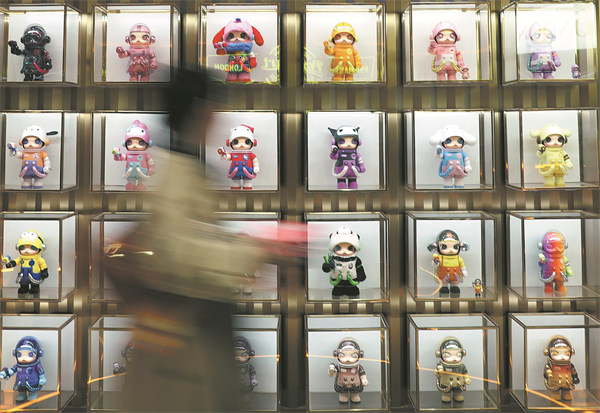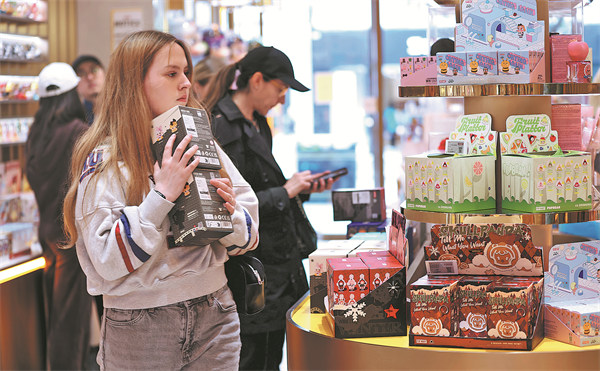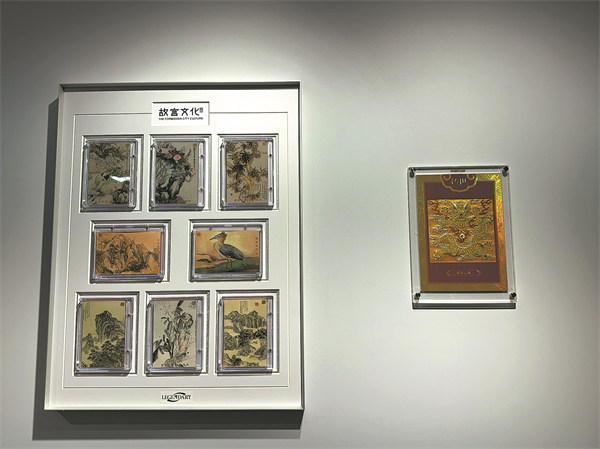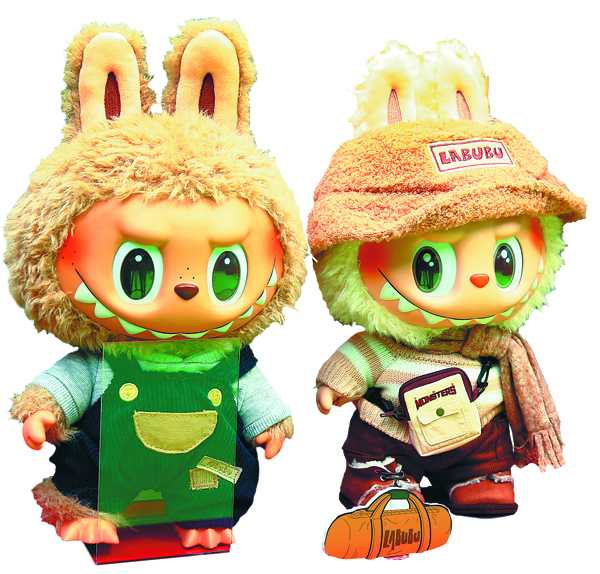
Customers purchase products at a Pop Mart store in London, Britain, on May 21. LI YING/XINHUA
Merging with IPs and using Chinese craftsmanship, traditional elements continue to fuel overseas traders' interest, Yang Feiyue reports.
Li Jing vividly remembers how an American collector carefully examined a card made by her company in his hand during the bustling US National Sports Collectors Convention at Donald E. Stephens Convention Center in Rosemont, Illinois, that was held at the end of July.
The card's surface gleams with a golden drawing of the Palace Museum's (in Beijing, also known as the Forbidden City) Hall of Supreme Harmony, its edges inlaid with delicate filigree, and at the center, a tiny natural gemstone.
This thin card, measuring less than a millimeter in thickness, embodies the marriage of centuries-old Chinese filigree inlay craftsmanship and modern industrial precision.
"The Hall of Supreme Harmony card is from our 'Heritage' series," says Li, a co-founder of Suplay, a Chinese designer toy and collectibles company founded in 2019.
The business produces collectible cards, trendy figurines, and pop-culture merchandise, operating under its card brand Kakawow.
This year marked the company's third invitation to Chicago to participate in the five-day convention, one of the world's largest card and memorabilia expos.
At Suplay's booth, wearing a Tang Dynasty (618-907) style jacket, Disney's Mickey Mouse stood out in playful contrast to the US entertainment company Warner Bros' 100th anniversary commemorative cards sitting next to collectible cards featuring photography from the Chinese National Geography magazine.
The US expo boasts a history of more than four decades. The floors are typically dominated by sports cards — basketball, baseball, and other sports-centered collectibles, such as jersey fragments or autographs. These remain the industry's gold standard, both culturally and economically.
Yet, at Suplay's booth, Forbidden City-themed cards drew equally big crowds. Nearly all of Suplay's showcased products were sold out on-site, purchased primarily by American collectors and distributors.
"These culturally infused collectibles are fast becoming favorites both at home and abroad," Li says.
Kakawow's first Forbidden City series was launched in 2020 and snapped up within two weeks. Its success was further cemented by its performance on secondary markets, where collectors resell items to other collectors. Resale prices for the cards soared significantly, confirming their status as coveted cultural artifacts, not just consumer products, Li notes.

Customers purchase products at a Pop Mart store in London, Britain, on May 21. LI YING/XINHUA
Though Suplay did not offer the Forbidden City series at this year's convention, many US collectors inquired about products related to the Palace Museum — a sign of a strong overseas appetite for Chinese cultural intellectual properties, Li says.
In recent years, trendy and collectible Chinese toys have gained remarkable popularity worldwide, with numerous brands expanding their reach overseas, generating overwhelming enthusiasm both online and offline.
Pop Mart stands out as a prominent example of this global success. By the end of 2024, Pop Mart had expanded to over 30 countries and regions, operating more than 500 physical stores and over 2,300 robotic stores.
TOP TOY, another major player, now operates more than 280 stores worldwide and reported exports worth approximately 47 million yuan ($6.6 million) in 2024.
Hong Yong, an associate research fellow in the Ministry of Commerce's e-commerce research department, notes that with the rise of China's economy and the enhancement of its cultural influences, trendy toys have served as a vehicle for cultural dissemination, successfully integrating Chinese elements with modern trends and demonstrating unique charm.
Hong adds that the overseas popularity of Chinese brands not only boosts their international visibility and influence but also strengthens the domestic market in return, creating a positive feedback loop.
Suplay's entrepreneurial journey began with a creative reinterpretation of traditional culture.
"For our premium card brand Kakawow, we chose the Forbidden City as the first IP because it represents one deep cultural consensus among Chinese people," Li recalls.
Their debut series — totaling 300 boxes — sold out in just two weeks, giving the team enormous confidence.
In 2024, Kakawow launched its "Heritage" series priced at 6,990 yuan, which incorporated intangible cultural heritage techniques such as filigree inlay.
Among them, the Cup of Eternal Stability edition was made using 81 grams of pure gold.
"The market response exceeded all expectations," Li says.
"Ninety-six percent of our buyers are adults over 18, which proves there is significant demand for high-end collectible cards in China," she adds.
Inside Kakawow's creative studio in Beijing, the East and the West merge in imaginative ways. Mickey Mouse dons a traditional Tang-style robe embroidered with auspicious cloud motifs. Beasts from the roof of the Hall of Supreme Harmony leap across holographic card foil.
"This blending of traditions is not only visual, but also rooted in the precision of Chinese manufacturing," Li says.

Collectible cards bearing the Palace Museum elements prove a hit among collectors from home and abroad. [Photo provided to China Daily]
She picked up a Warner Bros'100th anniversary card to demonstrate: "The PET (polyethylene terephthalate) film layer has a thickness deviation of less than 0.1 millimeters, and the gold stamping position tolerance is controlled within 0.3 millimeters. Only Chinese factories can achieve this level of consistency," she says.
According to a leading card-grading agency in the United States, 75 percent of Kakawow cards achieve a Gem Mint 10 rating, well above the US industry average of 50 percent.
Cao Wei, general manager of the card trading platform Card Hobby, established in 2014, has been a collector since 1997 and has witnessed China's collectible card culture grow over the years.
"To hold a piece of Michael Jordan's game-worn jersey embedded in a card carries immense emotional value for fans. It's not just a card; it's a tangible memory," Cao recalls. His collecting journey started with matchbox covers and stamps, then gradually moved toward modern trading cards.
Today, the platform processes transactions of nearly 300 million yuan monthly, with over 600,000 registered users worldwide, making it a key bridge that links Chinese card culture to global markets.
Though cards with Chinese elements currently account for just 5 to 10 percent of transactions, Cao sees tremendous growth potential.
"The challenge for cultural cards going global is IP appeal," Cao explains.
"You need international customers to buy in. You need a breakout story," he adds.
He cites Ne Zha as proof — after being licensed and distributed as a trading card series, the IP became highly active on the platform, proving to be a successful case of export of cultural product.

Toys themed on Labubu, a popular furry doll from Chinese toy company Pop Mart, at a new Pop Mart store in Bangkok, Thailand, in July 2024. SUN WEITONG/XINHUA
Industry veterans note that China's advantage in exporting designer toys and cultural collectibles lies in three areas: a robust supply chain; expertise in social media marketing and cross-border e-commerce; and a maturing, original design ecosystem.
Looking ahead, the outlook is bright. According to the Annual Report on China's Pop Toy and Animation and Comic Industries (2024), the country's designer toy industry is projected to reach 110.1 billion yuan by 2026, with annual growth above 20 percent.
Amid these shifts, Cao underscores the importance of patience.
"The card market requires long-term accumulation. We need time to become friends," Cao says.
He adds that Card Hobby will continue to advance China's card culture globally by participating in international expos, streamlining cross-border transactions, and releasing more products that blend Eastern and Western themes.
As for Suplay, the company plans to push further, experimenting with creative combinations, such as Dunhuang's flying apsaras with the movie Interstellar, and Song Dynasty (960-1279) elements with cyberpunk aesthetics.
"These seemingly contrasting elements will be woven into collectible cards, offering fresh stories with cultural fusion," Li says.
She believes that cultural elements going global cannot be measured by sales numbers alone.
"When I saw an elderly American gentleman at our booth using a magnifying glass to examine the Chinese characters Taihe Dian (Hall of Supreme Harmony), then looking them up to learn their meaning, I realized that cultural integration is truly happening," she says.
 Editor:Qiu Xiaochen
Editor:Qiu Xiaochen